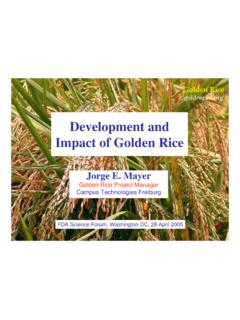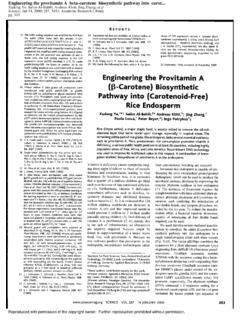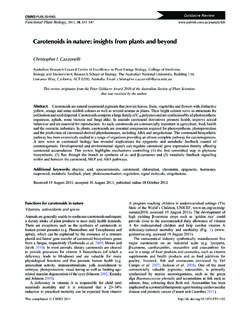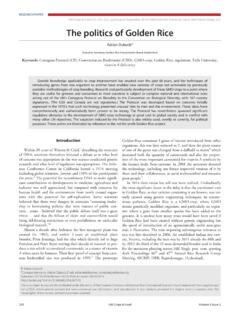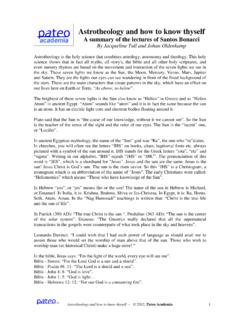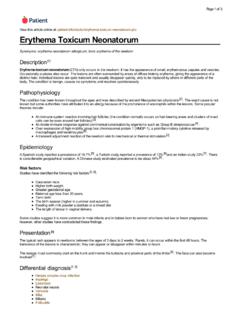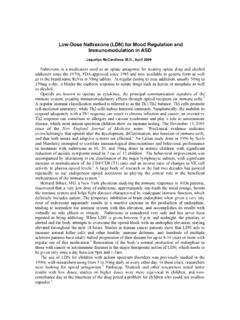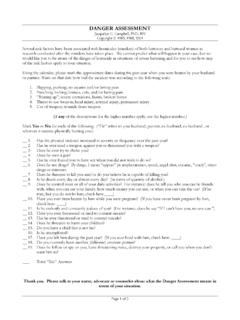Transcription of Improving the nutritional value of Golden Rice …
1 87 Improving the nutritional value of Golden rice throughincreased pro-vitamin A contentQ1 jacqueline A Paine1, Catherine A Shipton1, Sunandha Chaggar1, Rhian M Howells1, Mike J Kennedy1,Gareth Vernon1, Susan Y Wright1, Edward Hinchliffe2, Jessica L Adams3, Aron L Silverstone3& Rachel Drake1 Golden rice is a variety of rice engineered to produceb-carotene (pro-vitamin A) to help combat vitamin A deficiency1,and it has been predicted that its contribution to alleviatingvitamin A deficiency would be substantially improved througheven higherb-carotene content2. We hypothesized that thedaffodil gene encoding phytoene synthase (psy), one of thetwo genes used to develop Golden rice , was the limiting stepinb-carotene accumulation. Through systematic testingof other plantpsys, we identified apsyfrom maize thatsubstantially increased carotenoid accumulation in a modelplant system.
2 We went on to develop Golden rice 2 introducing thispsyin combination with theErwinia uredovoracarotene desaturase (crtI) used to generate the original GoldenRice1. We observed an increase in total carotenoids of up to23-fold (maximum 37lg/g) compared to the original GoldenRice and a preferential accumulation are a group of plant pigments important in the humandiet as the only precursors of vitamin A. Certain carotenoids, mostimportantlyb-carotene, are cleaved to vitamin A within the body andare referred to as pro-vitamin A3. Vitamin A deficiency, a majorproblem in parts of the developing world, can result in permanentblindness and increase the incidence and severity of infectiousdiseases4. In Asia, vitamin A deficiency is associated with the poverty-related predominant consumption of rice , which lacks pro-vitamin Ain the edible part of the grain (endosperm).
3 Providing pro-vitamin Ain a staple food such as rice could be a simple and effective com-plement to supplementation programs5because, through farming,it would be ubiquitous and rice is the name coined to describe the genetically modifiedrice1that produces carotenoids in the endosperm of the grain, givingrise to a characteristic yellow color. In this pioneering work, amaximum level of total carotenoids was achieved and has(ii)(i)Ubi1 Ubi1nosUbi1guspatnosPsynosabc02004006008 001,0001,2001,4001,6001,8002,000 EVAtDcNpZmCaOsLePsy transgene sourceTotal colored carotenoids(% based on empty vector)01020304050607080 Calli with high carotenoid content (%)Total colored carotenoidsFrequency of high carotenoidEV controlZm psyFigure 1 Expression of apsytransgene increases the carotenoid content of maize callus.
4 (a) Schematic diagram of the gene cassettes in the two plasmidsused to cotransform maize callus. Both contain the maize polyubiquitin1 promoter (Ubi1) and thenosterminator (nos). (i) The seven similar plasmidsconstructed with the phytoene synthase-coding region (psy) from each of the species listed below. (ii) The phosphoino N-acetyl transferase (pat) selectablemarker and beta-glucuronidase (gus) gene cassettes. (b) Photograph showing individual maize calli cotransformed with the plasmid containing the maizepsy(right, Zmpsy) and an empty vector (EV) control (left). (c) Histogram showing the total colored carotenoid content of maize calli transformed with a givenpsygene (fromArabidopsis thaliana(At),Daucus carota(Dc),Narcissus pseudonarcissus(Np),Zea mays(Zm),Capsicum annuum(Ca),Oryza sativa(Os) orLycopersicon esculentum(Le)).
5 Data shown represents the 75thpercentile for each population of transgenic calli expressed as a percentage of the medianempty vector (EV) control value . The secondy-axis (diamonds) shows the percentage of calli from each population with a carotenoid content more thanfivefold that of the EV online XX XX XXXX; doi:XXX871 Syngenta, Jealott s Hill International Research Centre, Bracknell, Berkshire, RG42 6EY, CTL, Alderley Park, Alderley Edge, Macclesfield, Cheshire,SK10 4TJ, Biotechnology Inc., PO Box 12257, Research Triangle Park, North Carolina 27709, USA. Correspondence should be addressed to BIOTECHNOLOGYADVANCE ONLINE PUBLICATION1 LETTERSnot been surpassed in subsequent experiments using alternative ricevarieties6,7. The limited production of pro-vitamin A in Golden rice iscited in the media as the major hurdle to the success of this particularsolution for vitamin A synthase is thought to be the limiting step for carotenoidbiosynthesis in some wild-type tissues and is viewed as a majorregulatory step8 10(a pathway diagram is shown inSupplementaryFig.)
6 1online). This was the case in canola seed, where sole expressionofcrtB(the gene encoding a bacterial phytoene synthase) led to asubstantial increase in carotenoid accumulation11. In wild-type riceendosperm, the first barriers to carotenoid biosynthesis are bothphytoene synthase and carotene desaturase, which are provided bythe daffodilpsyandcrtItransgenes in Golden limits the further accumulation of carotenoid in Golden no phytoene was accumulated (P. Beyer, University of Freiburg,personal communication), it appears that the desaturation of phy-toene to lycopene is proceeding efficiently using thecrtIgene hypothesized that PSY may still be the limiting factor in thistransgenic tissue.
7 Daffodil PSY protein is known to be present atsimilarly high levels in both the Golden rice endosperm and thedaffodil petal12which suggests either that it is insufficiently active orthat an alternative PSY functionality is required to overcome it beingthe rate-limiting step in the transgenic tissues that accumulate high levels of carotenoid have amechanism for carotenoid sequestration including crystallization, oildeposition, membrane proliferation or protein-lipid noncarotenogenic starchy rice endosperm is very low in lipid andapparently lacks any such means for carotenoid deposition. This initself may cap the carotenoid content of Golden rice at its low levelregardless of transgenic pathway capability14.
8 Another restriction inGolden rice could be precursor supply. We chose not to investigatethese hypotheses initially and in the course of our work duly demon-strated that they are of no immediate systematically testedpsycDNAs from alternative plant sources,particularly carotenoid-rich sources, with the aim of increasing thecarotenoid content of Golden rice . In an attempt to rank thesuitability of thepsys for use in rice , each was stably transformedinto inherently carotenogenic maize callus15(Fig. 1a). Marked differ-ences in performance of the variouspsys were obvious in terms ofboth the absolute amounts of carotenoid produced and in theproportion of highly colored calli (Fig.)
9 1b,c). Both of these measureswere judged to be indicative of potential transgene efficacy. The mostefficacious were maizepsy16, with a high carotenoid content, and anovel ricepsy(AJ715786, cloned for this work) with a high proportionof highly colored calli. Carrotpsy(AB032797), tomatopsy117,bellpepperpsy118andArabidop sis thaliana psy19were intermediate inefficacy. Daffodilpsy20performed least on ourpsyrank obtained from the callus experiments, themaize, tomato, pepper and ricepsycDNAs were individually used totransform rice , each with thecrtIgene (Fig. 2a). Daffodilpsywasincluded as a reference. Transgenic T1rice grains containing any of thefivepsycDNAs (withcrtI) were visibly yellow when polished, somewith a distinctly orange hue (Fig.
10 2b). Polished, nontransgenic seedswere white. The amounts of carotenoid produced by the differentpsyRBBabcdGluGluPsySSUcrtInosno snosnosUbi1hptIIRBZmGluGluPsySSUcrtInosn osnosUbi1pmi0246810121416182011586-28115 86-1411586-2011586-111586-1211059-411059 -1711059-1911059-1411059-57651-37651-176 51-27651-217651-197650-217650-147650-367 650-107650-377609-57609-137609-217609-16 7609-10 rice Maize Pepper Tomato Daffodil Individual transgenic eventCarotenoid content ( g/g dwt) Wild TypeNp Psy/crtIZm Psy/crtIPsy/crtIPsy/crtIPsy/crtIPsy/crtI Psy/crtIFigure 2 Carotenoid enhancement of the riceendosperm by transformation withpsyorthologuesandcrtI.(a) Schematic diagram of the T-DNAsused to generate transgenic rice plants.
